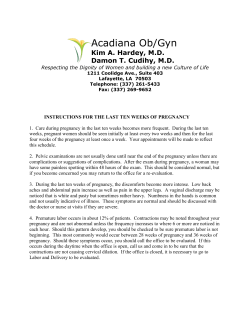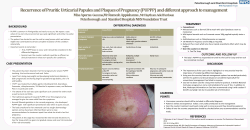
Molar Pregnancy Women’s Health Information for patients Oxford University Hospitals
Oxford University Hospitals NHS Trust Women’s Health Molar Pregnancy Information for patients You have been diagnosed as having a molar pregnancy, also called a hydatidiform mole. This leaflet will explain what molar pregnancy is and why it is important for you to be followed up. What is a molar pregnancy? A molar pregnancy is a pregnancy which will not develop into a baby and is the result of abnormal conception. It occurs in about 1 in 1200 pregnancies. In a molar pregnancy the placenta develops into a mass of fluid-filled sacs which looks like clusters of grapes. This mass grows in an uncontrolled way to fill the womb. It needs to be removed and most women can expect a full recovery. Sadly a molar pregnancy is a form of early pregnancy loss. There are two types of molar pregnancy: a complete hydatidiform mole and a partial hydatidiform mole. Complete mole This condition results when the sperm fuses with an egg that does not carry any of the mother’s genetic material. When this fertilised egg grows, no embryo is present in the pregnancy sac, only the placenta. Partial mole In this condition the egg allows two sperms to fertilise it. The embryo then has three sets of chromosomes (genetic instructions for creating a baby) instead of the usual two which means it could not develop into a baby. page 2 Why are molar pregnancies followed up? Close follow-up is needed after a hydatidiform mole because occasionally some molar tissue might remain and grow deeper into the wall of the uterus and spread – this is called an invasive mole. Very rarely a hydatidiform mole can develop into a choriocarcinoma, which is a form of cancer. If a cancer does develop, effective treatment is available and the cure rate is almost 100%. Symptoms You will probably bleed early in the pregnancy and the womb will seem bigger than it should be because a molar pregnancy grows more quickly than a normal pregnancy. Sometimes it can cause high blood pressure and thyroid problems. You may experience severe nausea. The overgrown placenta tends to produce excessive amounts of the pregnancy hormone hCG (human chorionic gonadotrophin). Most of the symptoms of a molar pregnancy are caused by the high hormone levels. Diagnosis A molar pregnancy can be diagnosed by: •a blood test showing very high levels of hCG in the blood •an ultrasound scan showing the particular appearance of a molar pregnancy •examination of the tissue by the pathologist when the pregnancy is removed. page 3 Treatment A molar pregnancy is removed in a small operation under general anaesthetic (you will be asleep). You will normally be admitted to the Day Case Unit and discharged the same day. A small tube is passed into your uterus through your cervix (the opening of your uterus) and the abnormal tissue is removed by D&C (dilatation and curettage) and suction. The procedure takes just a few minutes. The tissue is then sent off to the laboratory for examination under the microscope. What happens afterwards? After your operation the nurses will record your blood pressure, pulse and blood loss. You might need some mild painkillers, such as paracetamol. You should be able to go home the same day but may need to stay overnight if you have heavy bleeding. You may bleed on and off for up to 2 weeks and have mild cramping pains. These should reduce over this time. You can take over the counter painkillers, if required. It is better to use sanitary pads rather than tampons during this time. page 4 Risks of complications & side effects All operations carry some risks. For this operation the risks are: •Risks of general anaesthesia. Serious problems are rare. The doctor will discuss this with you in more detail. •Infection can occur (about 1 in 100 women) •Damage to the womb. It is possible for a tear to be made in your womb during surgery (1 in 500 women). •Pregnancy tissue being left in the womb. The operation would have to be repeated ( about 2-3 women in 100) Signs to look out for & who to contact If your pain increases or the bleeding gets worse to heavier than during a period contact your GP, the urgent gynaecology clinic or go to your nearest emergency department if it is severe. If you have any unpleasant vaginal discharge or a high temperature you should contact your GP. page 5 Follow up Blood levels of the pregnancy hormone hCG are measured weekly following a molar pregnancy. You will be registered at the follow-up centre in Charing Cross Hospital, London by your Gynaecologist. You do not have to travel to London. The necessary kit will be sent to you by the screening centre. In the kit there will be a letter for your GP and containers for urine and blood samples. You can arrange the blood test with your GP or come to the Blood Test Department in the Womens Centre, Level 1 at the John Radcliffe Hospital. The normal level of the pregnancy hormone hCG in the blood is less than 5IU/L (International Units of hCG per litre). Once the blood tests are normal, only urine samples will be needed. The minimum period for follow-up of complete and partial moles is 6 months. Your feelings You may feel upset after losing the pregnancy. Also you may be worried about the molar pregnancy persisting and the implications for future fertility and pregnancy. As time passes more often than not you learn to cope with your loss but if you need to talk to us or a counsellor please do not hesitate to contact us (see page 7 for contact numbers). page 6 Future pregnancy You must not get pregnant whilst you are being followed up because it will become difficult to know if your hCG levels are rising due to pregnancy or re-growth of the mole. You will have to wait 6 months after the hCG levels have returned to normal before getting pregnant. It is very important to tell the follow-up centre if you become pregnant. The chances of having a perfectly normal pregnancy after a molar pregnancy are very good. The risk of a further molar pregnancy is low (1 in 55). Contraception You will need to discuss contraception with your GP/Consultant. It is not advisable to use the contraceptive pill because if your hCG levels are still above normal, use of the pill may prolong the life of any remaining molar tissue. The contraceptive pill can be used safely after your hCG levels have returned to normal. The coil is also best avoided until your hCG levels are normal. Condoms or contraceptive caps may be used. How to contact us Gynaecology Ward 01865 222 001 Day Surgery Unit 01865 222 014 Urgent gynaecology clinic 01865 221 142 Counsellor 01865 221 235 Charing Cross Hospital 020 3311 1409 page 7 Further information www.molarpregnancy.co.uk/ www.patient.co.uk/health/Hydatidiform-Mole.htm If you need an interpreter or need a document in another language, large print, Braille or audio version, please call 01865 221473 or email PALSJR@ouh.nhs.uk Dr Subrata Majumdar Approved by Vic Rai, Consultant Gynaecologist Reviewed: July 2013 Next review: July 2016 Oxford University Hospitals NHS Trust Oxford OX3 9DU www.ouh.nhs.uk/patientinformation OMI 5266P
© Copyright 2025













